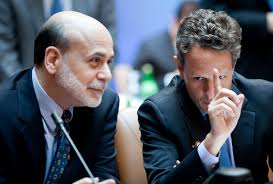Private credit money accommodation is a theory on the long-run transformation of the modern credit money system. During financial upswings, new forms of private credit money emerge as “shadow money”. At the end of the boom, they implode in a systemic financial crisis. When the state steps in and guarantees them, they are “accommodated” into the public money supply. Public money today is accommodated private credit money of the past.
The theory of private credit money accommodation carves out a major driving force that explains the way in which the modern credit money system has changed its shape throughout the previous centuries. What we know as public money today is not so much “fiat money”, a token that has been turned into money ex nihilo through state power and a legal act. Rather, contemporary state money consists of debt instruments that historically emerged through private innovation, for a while existed as private “shadow money” next to established forms of commodity money or public credit money, and only later were accommodated during a financial crisis.
The accommodation theory is a rethink of the fiat money concept. It views public money today as accommodated private credit money of the past.
Three key events led to a lasting accommodation of private credit money in modern capitalism:
- the 1797 run on the Bank of England, which initiated the ‘Restriction Period’ and accommodated bank notes;
- the 1933 Emergency Banking Act of Franklin D. Roosevelt, which accommodated bank deposits by introducing the deposit insurance and ended the Great Depression; and
- the 2008 emergency interventions of the Federal Reserve and the US Department of Treasury, which accommodated overnight repos and money market fund shares.
Bank notes, deposits, money market fund shares and overnight repos make up what we can understand as the public money supply today. The lasting accommodation of a private credit money form takes place in the centre of the global financial system and subsequently spreads to the periphery.
The 2007-9 Financial Crisis was an accommodation of shadow money instruments that had been on the rise since the 1970s. The crisis interventions have defined a new role of public institutions in the credit money system.
A two-phase model of private credit money accommodation
Private credit money accommodation is a process that repeats itself throughout history. It can be depicted through a two-phase model using the analytical tool of the ‘Money Matrix’ (Pozsar 2014). In the first phase, a new form of private credit money emerges. In the second phase, it is accommodated into the public money supply.
According to the Money Matrix, the money supply at a given point in time is made up of both public and private credit money forms.
- Public credit money forms are either pure public money, which is directly issued by a state institution, or private-public money, which is issued by a private institution but publicly guaranteed through liquidity and solvency backstops.
- Private credit money forms are private debt instruments that trade at par to public money forms but do not have any public guarantees. When they are issued against a public security, they count as public-private money. If they are issued against a private security, they are pure public money.
In Phase I (‘pre-accommodation’), existing credit money forms increase in volume and new forms of private credit money come into being due to financial innovation. A new debt certificate (IOU) ‘enters’ the Money Matrix: It becomes pure private money if issued against private assets or public-private money if issued against public assets. The duration of this pre-accommodation phase cannot be determined with certainty, but it makes sense to think of it as an institutional evolution that stretches well over decades.
A given credit instrument has to satisfy four criteria to be considered a systemically relevant private credit money form: First, from a supply side perspective, it must be a short-term IOU that is held by the issuing institution as its liability and that has been created on the basis of a swap of IOUs of different maturities. Second, from a demand side perspective, this short-term IOU is held as an asset by agents who consider it ‘cash’, i.e. the most liquid form of an asset capable of doing immediate purchases of commodities or other financial assets. Third, the IOU constitutes a promise to pay higher-ranking money to which it trades at par or quasi-par and in which it is instantaneously or almost instantaneously convertible. The aspect of par clearance vis-à-vis higher-ranking money forms is what ultimately makes the IOU ‘money’ in the sense of being part of the Money Matrix. Fourth, from a systemic perspective, it is systemically relevant if its default would lead to a systemic crisis and an implosion of the wider credit money system.
In Phase II (‘accommodation’), a crisis emerges in the financial system. For any reason that cannot be known ex ante, the expansion of the credit cycle comes to a halt. The imminent threat sets in that the debt network might implode, expressed via a run on the issuers of private credit money, and the real chance of their default. The credit money system relies on the implicit or explicit promise that the credit money forms can be converted into a hierarchically higher form of money at par. If this promise is no longer perceived as credible among holders of private credit money, a panic materializes within the private credit money realm.
Confronted with such a run, policy-makers face the pressure to rescue the defaulting private credit money issuers. Responsibility for the emergency response to the systemic crisis sooner or later ends up at the highest levels of government where the people in charge have to decide under extreme time pressure and uncertainty. High-level politicians are confronted with a doomsday scenario: The default of those institutions would imply that masses of wealth created prior to the crisis and now held as credit money balances would annihilate. To avoid these consequences, policy-makers establish mechanisms to provide liquidity and solvency support to the defaulting institutions. This calms down the panic in the monetary system and rescues the issuers of the systemically relevant credit money form.
As an unintended side effect of the bailout, policy-makers acknowledge that the private credit money form has taken on a systemic role and that the monetary economy is no longer able to function smoothly without it. By granting emergency support to its issuer(s), they let the issuing institution(s) tap public balance sheets. This establishes an ad hoc public framework to ensure that the systemically relevant private credit money balances do not annihilate via a default of their issuers. Via this framework, the public authorities unintentionally accommodate the formerly private credit money form in the public money supply. This induces a transformation of the monetary system and provides for a new setup of the money supply with now a new combination of public and private credit money forms co-existing next to each other.
Three cases of private credit money accommodation
There are three manifestations of the two-phase model that led to a permanent accommodation of private credit money. Each instance of accommodation was followed by fierce debates about monetary theory and the right strategies to deal with the accommodated credit money form.
Phase I ('pre-accommodation'): Bank notes as private credit money form developed throughout 18th century Britain. Main suppliers were the Bank of England (founded in 1694) and country banks, which developed from 1750 onwards. During the ensuing first wave of the Industrial Revolution, the number of country banks as increased sharply and the volume of circulating country bank notes expanded massively. Country banks were the “shadow banks” of the age.
Phase II ('accommodation'): The accommodation occurred after the outbreak of the French Revolutionary War in 1792, which was associated with the financial crises of 1793 and 1797. In February 1797, as a reaction to the depletion of the Bank of England’s bullion reserve, the government—via an Order of the Privy Council and later backed by Parliament with the Bank Restriction Act—initiated the ‘Restriction Period’ by suspending cash payments and thus decoupling Bank of England notes from their gold base. The Restriction turned Bank of England notes into private-public money: A liquidity backstop was established via the legal proclamation that Bank of England notes were a promise to pay nothing else but themselves—they were turned into an ultimate means of payment; and a solvency backstop was created by the government’s guarantee to accept an unlimited amount of Bank of England notes for tax payments.
After the accommodation, various parliamentary committees analyzed and debated the status of bank notes, and tried to come to grips with that credit money form. The regulatory process took until the Bank Charter Act of 1844 which turned bank notes into pure public money. The Act re-defined bank notes as mere gold certificates and made their issue based on government law. Private note issue by country banks was prohibited, the Bank of England was split up into a Banking and an Issue Department. While the Banking Department continued with its classical banking operations and kept up its activity of private credit money creation in the form of bank deposits, the Issue Department became effectively a government agency with a nation-wide monopoly of bank note issuance. Accordingly, new tools for governing the bank note supply were invented. The role of bank notes as credit money under government control successively spilled over to other states in Europe and North America.
 Accommodation of bank notes in 1797: Prime Minister William Pitt attacks the Bank of England (the Old Lady of Threadneedle Street), Image: wikipedia.org
Accommodation of bank notes in 1797: Prime Minister William Pitt attacks the Bank of England (the Old Lady of Threadneedle Street), Image: wikipedia.org
Phase I ('pre-accommodation'): Bank deposits have existed even longer than bank notes. Yet, they became systemically relevant as a private credit money form only after the accommodation of bank notes when they began to trade at par to bank notes and commodity money. In the U.S., the number of banks and especially deposit-issuing trust companies (the shadow banks of the age) increased sharply in the late 19th century, which made the volume of deposits in the financial system multiply. In 1913, the decision was taken to follow the British model and to put in place liquidity backstops for bank deposits by establishing the Federal Reserve, which—at this time—was still a privately controlled institution.
Phase II ('accommodation): The accommodation was initiated by the 1929 Financial Crisis. In the subsequent Great Depression, the U.S. financial system was subject to a multi-annual banking crisis, which appeared in four waves between 1930 and 1933. It could only be stopped when newly elected President Franklin Delano Roosevelt declared a National Banking Holiday and, by holding his First Fireside Chat on radio and passing the Emergency Banking Act in March 1933, announced an implicit 100% government guarantee for bank deposits. This established an ad hoc solvency backstop and turned deposits into a form of private-public money.
After the accommodation, a short regulatory process ensued and led to the Banking Acts of 1933 and 1935. These acts passed permanent regulations for deposits as a private-public money form. On one hand, they improved the public liquidity guarantee for bank deposits by re-organizing the Federal Reserve System and putting it effectively under public control. On the other hand, by bringing the Federal Deposit Insurance Compancy (FDIC) into being, they provided an explicit solvency backstop for deposits in case of the issuing bank’s insolvency. In addition, they introduced strict prerequisites regarding the regulation and supervision of banks—first and foremost the separation between commercial and investment banking. Over time, the public-private partnership for bank deposit creation with publicly provided liquidity and solvency backstops became the norm internationally.
 Accommodation of bank deposits in 1933: US President Franklin D. Roosevelt publicly guarantees bank deposits in his First Fireside Chat, Image: wikipedia.org
Accommodation of bank deposits in 1933: US President Franklin D. Roosevelt publicly guarantees bank deposits in his First Fireside Chat, Image: wikipedia.org
Phase I ('pre-accommodation'): From the 1970s onwards, three forms of shadow money have developed in the U.S.-based shadow banking system as substitutes for commercial bank deposits: asset-backed commercial papers (“ABCPs”), MMF shares and overnight repos. Those shadow money forms are short-term debt instruments issued by different non-bank financial institutions or ‘shadow banks’: ABCPs are the liabilities of Special Purpose Vehicles (“SPVs”)—entities set up by large commercial banks as off-balance-sheet institutions to conduct banking functions while circumventing capital requirements. Overnight repos are private debt instruments constructed around the sale and repurchase of securities. They are issued by Securities Dealers who act as market makers for repos. MMF shares are the liabilities of MMFs, which pool the funds of households and institutional investors on the retail money market to invest them in the shadow banking system. Government MMFs invest only into government securities, whilst Prime MMFs buy predominantly private debt.
Phase II ('accommodation'): The accommodation of shadow money took place during the 2007-9 Financial Crisis. While ABCPs were demonetized in the first wave of the crisis due to the Federal Reserve’s intervention in autumn 2007, MMF shares and overnight repos became private-public money in 2008. During the second wave of the crisis, around the near-failure of Bear Stearns in March 2008, the Federal Reserve used its emergency powers to establish the Primary Dealer Credit Facility (PDCF) and the Term Securities Lending Facility (TSLF) which jointly functioned as a public liquidity backstop for repos issued with high-quality government debt as collateral. In September 2008, during the third wave of the crisis associated with the collapse of Lehman Brothers, this liquidity backstop was extended to repos with lower quality collateral. At the same time, the U.S. Treasury established an ad hoc solvency backstop for MMF shares by announcing its ‘Temporary Guaranty’.
After the 2007-9 Crisis, a regulatory process set in which confirmed the accommodation of overnight repos and Government MMF shares but de-monetised Prime MMF shares. The latter dates back to a decision of the Securities and Exchange Commission taken in 2014 which prohibited Prime MMF shares from keeping up the constant net asset value for its shares and thus forced MMF shares to break par vis-à-vis bank deposits. Although the explicit emergency backstops for Government MMF shares and overnight repos were removed in 2010, they still remain in place as implicit guarantees. In addition, the Reverse Repo Facility functions as a permanent discount window for repo-issuing securities dealers. However, the process of medium-term regulation of contemporary shadow money can be seen as ongoing, and in terms of monetary governance tools, while authorities are still navigating on sight, various ideas circulate as blueprints in the discourse on contemporary shadow money.
 Accommodation of repos and money market funds in 2008: Heads of the Federal Reserve Ben Bernanke and Timothy Geithner establish emergency lending facilities, image: flickr.com
Accommodation of repos and money market funds in 2008: Heads of the Federal Reserve Ben Bernanke and Timothy Geithner establish emergency lending facilities, image: flickr.com




